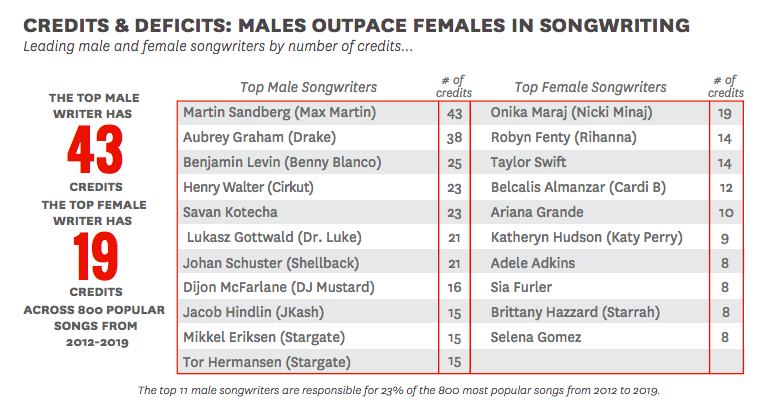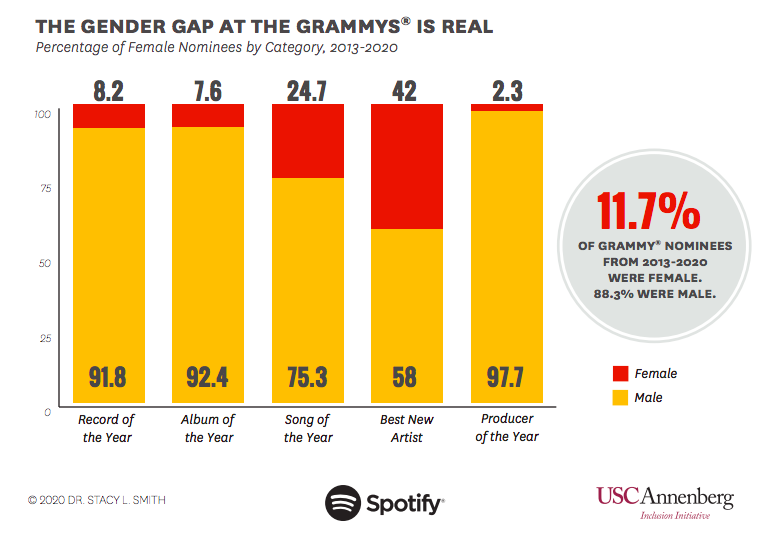6 Findings that Show the Gender Gap in the Music Industry Is Real
Women are shut out from nearly every creative space in the music industry–here are the numbers that prove it

Percentage of women across three creative roles in the music industry according to the USC Annenberg Inclusion Initiative. Photo: Courtesy of the Annenberg Inclusion Initiative
While we’re at the dawn of a new decade, the USC Annenberg Inclusion Initiative’s 2020 edition of Inclusion In the Recording Studio? reveals that very little has truly changed for women and people of color in music. Spearheaded by Dr. Stacy L. Smith with Dr. Katherine Pieper, Hannah Clark, Ariana Case and Marc Choueiti in collaboration with Spotify, the Annenberg Inclusion Initiative is a quantitive study and report on the gender and ethnicity of artists and content creators across 800 popular songs from 2013 to 2020. The report is an annual process with the 2020 edition the third of its kind.
The tracks deemed ‘popular’ were chosen for examination as per their performance on Billboard’s annual Hot 100 chart. The study also includes the examination of Grammy nominees within the same time-frame. In addition to reporting the numbers of men and women within various creative spaces in music, the investigation examines the barriers facing female songwriters and producers through a set of qualitative interviews. Below are some of the findings.
Women are missing in popular music. Out of 172 artists featured on the Hot 100 Year-End Billboard Chart in 2019, 131 were male (76.2%) , 38 (22.1%) were female and two (1.2%) were gender nonconforming. One company also received a credit as an artist. It should be noted that 2019 featured a significantly higher percentage of female artists (22.5%) than 2018 (17.1%) or 2017 (16.8%). In terms of genre, women did best in Pop, making 32.6% of all artists across the eight years. The genre that featured the least women was Alternative, with only 11% of the artists being women. Overall, women represent less than one third of all performers on the charts.
There are 5.9 male songwriters to every one female songwriter. The amount of songwriting credits awarded is perhaps the biggest sign of the super unbalanced gender ratio in the industry. In 2019, out of the 513 songwriting credits examined, 74 (14.4%) were for women and 439 (85.6%) were for men. According to the report, the most discrepancy in songwriting credits was found at the top performer level–the top two male songwriters have twice as many songwriting credits than the top female songwriter at 43 and 38 versus 19 credits, respectively. The Annenberg Inclusion report states, “The 11 top male songwriters (eight white, three underrepresented) wrote or co wrote 23% of our sample.” Only three songs did not have a single male songwriter attached and just 9.1% of the songs featured only one male songwriter. Over 56% of songs however, did not feature a single female songwriter. The report goes on to conclude, “Thus, 88.4% of the eight-year sample either erases female writers altogether or tokenizes them in the artistic process.”

Photo: Courtesy of the Annenberg Inclusion Initiative
Female producers are too few and the number of female producers of color is negligible. The ratio of male to female producers on a sub sample of 500 tracks (chosen from the Hot 100 Year-End Billboard Charts) from 2013-2020 was found to be at a shocking 37 to one. Out of the 1,093 producing credits, only 29 (2.6%) were women across the eight-year sample. This means over 97% of the producers receiving credit were men, making for a gender ratio of 36.7 males to every one female producer.
Women are also much more likely to find a place on the charts as solo artists. Only 353 out of the 800 songs were by women, out of which 309 were by solo artists, 37 were by bands featuring women and only seven by duos featuring women.

Courtesy of the Annenberg Inclusion Initiative
Only 11.7% of Grammy nominees from 2013-2020 were female with 88.3% being male. The report focuses on the nominees for Record of The Year, Album of the Year, Song of the Year, Producer of the Year and Best New Artist. The only category that has seen a major surge in nominations for women over time was Best New Artist. 2019 was a great year for women (and women of color) with Cardi B becoming the first solo female artist to win Best Rap Album, Kacey Musgraves winning Album Of The Year and Dua Lipa grabbing Best New Artist. Five out of the eight nominations for Album Of The Year were women, including Carlile, Cardi B, Janelle Monae and H.E.R. With the 2020 nominations featuring the highest percentage of women nominated for Song of the Year and Album of the Year yet, the outlook isn’t too bad.
The percentage of artists of color on the charts has seen steady increase in the last eight years. A majorly positive finding, the report states that round 45.4% of the artists behind 800 songs examined from 2012-2019 were artists of color with 2019 featuring the highest number of artists at 56.1%. A lot more voices are being heard than before, especially via genres like hip-hop and R&B for men and dance and pop for women. The flipside however is that hip-hop and rap are also the most exclusionary to women.







